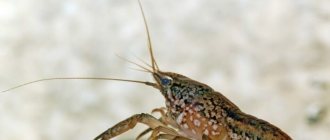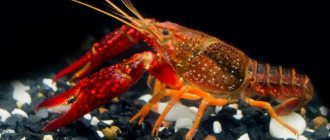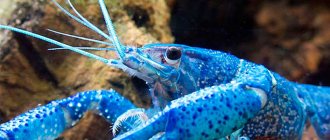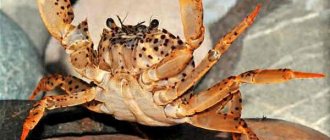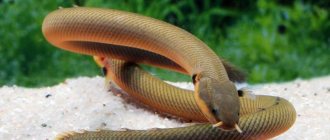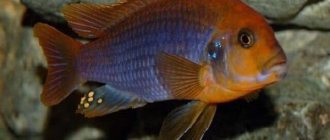The marbled crayfish (Procarambus virginalis) is a unique creature that you can keep in your aquarium. Each of them can reproduce on its own, in much the same way that plants reproduce by seeds without the participation of other plants.
Each individual is a female, but they reproduce by parthenogenesis, and can over and over again produce babies that are exactly like their parents. The good news is that they are unpretentious in content and interesting in behavior.
Marbled crayfish - who are they?
Gray-spotted or marbled crayfish live in fresh rivers. The exact origin is unknown, but these animals were first discovered in Germany. The name of the crayfish is related to the color of the shell. The surface of the body can have different shades of brown, green or black. The shell is covered with a beautiful pattern, reminiscent of stains on the surface of marble. The coloring of young individuals is weakly expressed, but with age the contours of the patterns become clearer and the contrast becomes brighter.
The pattern on the crayfish's shell gives the species its name.
The animal has the same shape as common crayfish. Five pairs of legs, cephalothorax, claws. The body length of an adult reaches 12-15 centimeters. Newborn crustaceans are so small that they are difficult to notice. But they grow actively after each molt, and quickly reach large sizes.
There are several types of marbled crayfish. In addition to the usual ones, there are Cuban marble ones. A distinctive feature of this species is the blue color of the shell.
Where do crustaceans live?
The country of origin of Marbled crayfish is the reservoirs of Germany. It was here that crustaceans were first discovered, after which they were successfully spread throughout other countries. Today, crayfish can be seen in countries such as Madagascar, Japan, the USA and some European countries.
The homeland of the Marbled crustacean is not known, but it was first discovered by the Germans in Germany
The prevalence of Marble cancer is due to its unpretentiousness. The crustacean thrives in wide ranges of water. In addition, crayfish are omnivores , making it easier for them to survive in various bodies of water.
This cancer is very unpretentious
Maintenance and care
Keeping marbled crayfish is not very difficult.
This is an animal that is nocturnal. Animals are quite active and need free space to move. It is also necessary to create a slight movement of water.
Filtration and aeration are vital for crayfish.
If the volume of the aquarium reaches 100 liters, then it can contain no more than two individuals. Water changes should be done approximately twice a month.
Among the plants that can survive are algae that float in the water column or on its surface. The pet will eat all the plants that are available.
Aquarium
This animal can live in a reservoir of 40 liters or more. But because Crayfish are very sloppy; during their life, a large amount of garbage is formed. If you keep several individuals, it is better to choose a large tank with a volume of 100 liters or more. In such an aquarium, crayfish grow larger and more beautiful.
You can buy a shelter for cancer in a store or make it yourself from pipes, pots, or coconut shells.
In order for the marbled crayfish to feel comfortable in the aquarium, you need to arrange a shelter. Sand with coarse fractions or gravel should be placed at the bottom of the reservoir. To organize shelters, you can use coconuts, driftwood, pots and other items at your discretion. Each individual must have a separate den.
To clean the aquarium from debris, you will need a powerful filter, which will additionally create a current. Since arthropods are demanding of oxygen concentration, it is best to supplement the aquarium with aeration. You can also place a floating piece of driftwood on which to sit comfortably and breathe air. Females with eggs need increased oxygen concentration. Content temperature – +18-28 С. The pH level can range from 6.5 to 7.8 units.
A siphon is a simple but indispensable tool for cleaning aquarium soil.
The water in the aquarium should be changed regularly. When replacing water, you should siphon the soil in order to remove rotten debris.
The pet is able to escape from the container and die from lack of moisture. To avoid dangerous situations, it is worth covering the aquarium with a lid.
Keeping in an aquarium
Marble crayfish, the maintenance of which will not cause much trouble, requires a lot of space. One river inhabitant should have at least 5 liters of water. The best solution would be to purchase a 100-liter tank, which must be equipped with a lid, because it costs nothing for the crayfish to climb out of the reservoir. The aquarium is also equipped with a filter and aerator to create comfortable living conditions.
Water parameters:
- acidity – 6.5–7.5 pH;
- hardness – 8–12 dH;
- water temperature is 20–28C.
Relations with neighbors
Large and predatory fish may consider crayfish an addition to their diet and eat them. Cichlids are especially dangerous. Also, you should not keep crayfish and catfish in the same reservoir, since the latter can become food for arthropods. It is not advisable to breed fish with veil-like fins, since the crayfish will too often be tempted to catch and tear off the fins.
If cancer is dangerous for some fish, then others themselves can seriously injure or even kill a molted crayfish with a fragile shell. However, many people manage to successfully keep crayfish and fish in the same aquarium.
You can keep swordtails or guppies in the same aquarium with arthropods. But you should be prepared for the fact that small fish may eventually become food for the animal. All fish that live in an aquarium must swim quickly so as not to get into arthropod’s dinner.
Cancer will do the same to snails.
Neighborhood with fast, active fish that do not show aggression is allowed.
Shared keeping with other species of underwater inhabitants
Individuals of this species can be placed in the same aquarium with fish, however, crustaceans may not coexist peacefully with everyone. Large predatory individuals pose a danger to crustaceans, and you should not place them next to fish that prefer to live on the bottom. Such undesirable neighbors include catfish of various varieties. If you place these individuals with crustaceans, the latter will definitely eat them.
Invertebrates also pose a danger to slow-swimming fish with veil fins, as they can cause injury to them. Ideal neighbors for marbled crayfish would be swordtails, guppies and tetras. These small, nimble fish do not pose a danger to invertebrates, and it will be extremely difficult to catch them. In other words, marbled beauties can live comfortably next to those species of fish that are not afraid of cancer, but they are not prone to aggression either.
Diet
The main component of the diet is plants. You can feed the animal with special sinking granules, tablets or vegetables. Plants that can serve as food for animals:
- dandelion leaves;
- spinach;
- salad;
- zucchini;
- cucumbers;
- corn;
- young beans;
- peas.
The plants are scalded with boiling water and then fed to crayfish. Large pieces should be chopped.
Approximately once every seven days the diet is supplemented with protein foods. You can give boiled fish fillets, pieces of boiled liver, shrimp meat, snails or live food.
Dry food for crustaceans is produced by the following companies: Sera, JBL, Tetra, Dajana. These are balanced feeds suitable for the daily diet.
Cancer can only feed on special dry granules, but then there is a high risk of problems with molting, growth and immunity. Therefore, we recommend feeding the crustacean with the products listed above from time to time.
Feeding
Gray-spotted inhabitants of aquariums are unpretentious in food, and feed mainly on plant foods. The list of recommended products for feeding your pet looks like this:
- dry food;
- spinach;
- lettuce and cabbage leaves;
- grated carrot;
- zucchini;
- peas;
- corn.
The food is served in crushed form; the food is first scalded with boiling water. For full development and a strong shell, once a week the crustacean is given protein food: pieces of fish, liver or small shrimp and shellfish. Marbled arthropods are fed in the evening.
Features of reproduction
All individuals of marbled crayfish are females. Marbled crayfish reproduce by parthenogenesis. Reproduction does not require two individuals. With this method, unfertilized eggs fully develop. Young individuals are completely identical to their parents.
The female carries the fry under her tail until the crayfish are able to feed on their own.
The reproduction rate is so high that in some countries they are prohibited from being sold because they can crowd out native species. This species poses a threat to local ecosystems due to its fertility, unpretentiousness in food and excessive appetite.
The ability to reproduce occurs between the ages of two and five months. At a time, the female gives birth to from 20 to 70 small crustaceans. If an animal begins to hide for a long time in various shelters, then it’s time to reproduce. The gestation period for eggs is about a month.
Breeding requires the organization of a separate aquarium. The animals are cannibals, so the female is removed from the spawning ground a day after the onset of labor.
Juveniles eat the same food as adult crayfish. Large feed should be ground into dust.
Maturation of juveniles
In the life of a crayfish, the process of molting occurs quite often. A few days before this process begins, the cancer loses its appetite and seeks shelter. Until the new shell gets stronger, the pet needs a reliable shelter where it can sit quietly. The old shell should be left in the pond, the cancer will eat it, since it contains calcium and other necessary building materials for the new armor.
Young animals should not lack food, otherwise cases of cannibalism cannot be ruled out.
Description and characteristics
In their natural habitat, marbled crayfish are river arthropods belonging to the order Decapods. The second name for the cancer is gray-spotted, because its marbled color has gray, brown and dark spots.
Externally, the aquarium marbled crayfish is very similar to its wild relatives, but is slightly larger in size than the ordinary species of river arthropod. The color of the pet varies from green to coffee or black shades, and the shell is decorated with patterns reminiscent of marble patterns. In young crayfish they are barely noticeable, but adult specimens can boast of clear and bright stains on the shell.
Marbled crayfish grow up to 15 cm in length, including antennae. However, it is worth noting that the final size of the pet will depend on the conditions of detention: a large arthropod is unlikely to grow in a small and cramped body of water.
During daylight hours, river inhabitants are inactive, but with the onset of darkness, crayfish awaken in vigor and strength. When moving into a common tank, aquarists take into account the character of the pet: the marbled arthropod has no sugar at all, the crustaceans have difficulty getting along with other fish, relatives and mollusks.
A distinctive feature of the species is its good predisposition to reproduction: gray-spotted crayfish produce tiny, barely noticeable crustaceans in quantities of 20 to 100 individuals at a time.
In aquariums, marbled pets often shed, shedding their old protective coating along with their claws. There is no need to be frightened by the spectacle, since for crayfish this is a natural process that does not harm the creature one bit. The old shell of an aquarium crustacean is not thrown away, because the pet eats it, thus receiving the calcium the body needs. After being shed, the pet diligently hides in the depths of the reservoir for several days, hiding from prying eyes, until a new shell grows. The average lifespan of an arthropod is 1.5 years.
Interesting fact: the intensity and richness of the color depends on the color of the soil and the conditions of the aquatic environment.
Is it possible to eat marbled crayfish?
Despite the fact that this species is considered decorative, marbled crayfish are practically no different from ordinary river crayfish. But there is no exact information about the safe use of these arthropods.
Marbled crayfish are bright and unusual aquarium pets.
For successful maintenance and breeding, it is enough to provide the crayfish with comfortable living conditions. It will decorate the aquarium and produce a large number of offspring. Such pets are suitable for those who love unusual animals.
Are they edible or not?
There is no information about the possibility of consuming representatives of Marbled crayfish for food. This is a completely decorative species, although the body structure of Marbled crayfish is not particularly different from other crustaceans, which many people like to eat. Therefore, if you want to diversify the fauna in your aquarium , then introducing Marbled crayfish is a great idea.
Following a few simple recommendations for arranging an aquarium will allow you to acquire a nice crustacean that adorns a small marble shell. The main thing is desire and a little patience, and soon all friends and guests will not be able to take their eyes off the aquarium decorating the apartment.
See also : Mexican dwarf crayfish in the aquarium. In addition, you will probably be interested in the article about the blue Cuban crayfish.
How to fix moss, anubias, bucephalandra in an aquarium
Nitrates in the aquarium: how to reduce, check, fight and maintain
The smallest aquarium fish: types and care for them
TOP 20 most beautiful aquarium fish
TOP 12 most expensive aquarium fish
Aquarium fish that do not spawn, but give birth to fry
The water in the aquarium becomes cloudy: the reason, how to eliminate it
Heater for an aquarium. Temperature in the aquarium
Structure and size
The marbled crayfish is not much different in appearance from other types of crayfish. The length of the body including the mustache does not exceed 12–15 cm, but newborn babies are so small that you need to look closely to distinguish them. The crayfish grows with each molt, and their lifespan averages 18–24 months.
Body color varies from blue and green to brown and gray-black, while the back of the arthropod is decorated with an ornate pattern reminiscent of marble stains. In young individuals the pattern is practically indistinguishable, but the older the arthropod becomes, the more clearly the marble pattern is visible.
The body of the cancer consists of a cephalothorax and abdomen, covered with a durable chitinous shell. The head contains eyes, antennae and mouth openings. The limbs are divided into jaws (help in eating) and walking limbs for movement.
Learn how to keep a hermit crab in an aquarium.
Breeding
The reproduction of marbled crayfish is their peculiarity. They reproduce in a rather interesting way - parthenogenesis. This means that all individuals are of only one sex - female. Their eggs are capable of developing into full-fledged embryos without fertilization.
The female carries the eggs for about a month, trying to hide in shelters. At one time, 50-100 crustaceans are born. Since crayfish love to feast on their own young, the female will need to be removed. But not immediately, as soon as you see the first babies - the process of birth of crustaceans takes up to a day.
Because newborn crayfish are very small, catching the fry is not easy. It is better to transplant the female into a separate aquarium before breeding begins. Small crustaceans eat from the first minutes of life, the food is the same as that of adults - plant foods with the addition of proteins.
Breeding crayfish is a responsible business, if only because they are quite prolific. Therefore, it is better to immediately decide what you will do with young crustaceans.
Return to content
